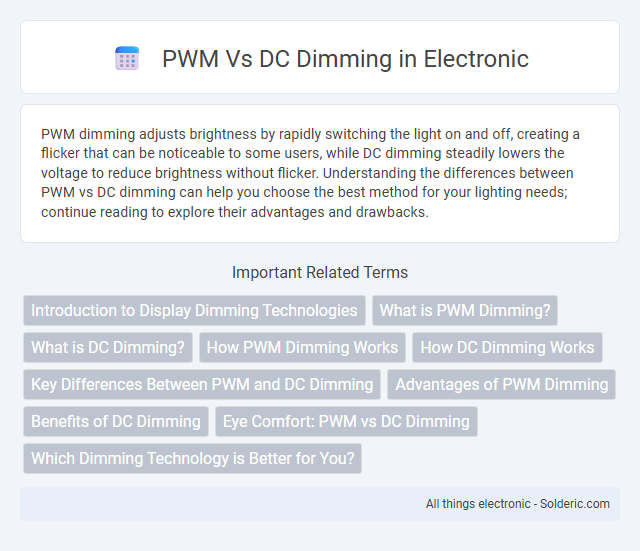PWM dimming adjusts brightness by rapidly switching the light on and off, creating a flicker that can be noticeable to some users, while DC dimming steadily lowers the voltage to reduce brightness without flicker. Understanding the differences between PWM vs DC dimming can help you choose the best method for your lighting needs; continue reading to explore their advantages and drawbacks.
Comparison Table
| Feature | PWM Dimming | DC Dimming |
|---|---|---|
| Definition | Pulses power on/off rapidly to adjust brightness | Adjusts brightness by varying direct current to LED |
| Brightness Control | Uses pulse width modulation frequency | Changes LED current intensity continuously |
| Flicker | Possible visible flicker at low frequencies | No flicker, smooth brightness transition |
| Eye Comfort | May cause eye strain or headaches due to flicker | Improved comfort, reduced eye strain |
| Energy Efficiency | Efficient with minimal power loss | Less efficient, may produce heat due to current changes |
| Color Accuracy | Stable color output | Potential color shifts at low brightness levels |
| Implementation | Requires frequency control circuitry | Requires precise current regulation hardware |
| Usage | Common in smartphones, monitors, LED displays | Used in high-end displays and devices prioritizing eye comfort |
Introduction to Display Dimming Technologies
Display dimming technologies such as PWM (Pulse Width Modulation) and DC dimming control screen brightness by adjusting the power delivered to the backlight or pixels. PWM dimming rapidly switches the display's backlight on and off at varying intervals to reduce brightness, which can cause flickering perceptible to some users, especially at lower brightness levels. DC dimming reduces brightness by lowering the direct current flowing through the display components, providing flicker-free lighting that benefits users sensitive to flicker or experiencing eye strain.
What is PWM Dimming?
PWM dimming, or Pulse Width Modulation dimming, controls LED brightness by rapidly switching the light on and off at a high frequency, adjusting the duty cycle to vary perceived luminosity. This method maintains color accuracy and energy efficiency while reducing flicker visibility to the human eye when properly implemented. PWM dimming is commonly used in displays and lighting systems to achieve precise brightness levels without altering the current supplied to the LEDs.
What is DC Dimming?
DC dimming adjusts screen brightness by directly varying the voltage supplied to the display's backlight, ensuring a stable light output without flickering. This method reduces eye strain compared to Pulse Width Modulation (PWM), which rapidly switches the backlight on and off at varying intervals. DC dimming is particularly beneficial for users sensitive to screen flicker, enhancing comfort during prolonged device use.
How PWM Dimming Works
PWM dimming controls LED brightness by rapidly switching the power on and off at a frequency imperceptible to the human eye, effectively adjusting the duty cycle to vary light intensity. This method efficiently maintains color accuracy and reduces heat generation compared to DC dimming, which lowers voltage continuously. Understanding PWM dimming helps you optimize screen performance and minimize flicker-related eye strain.
How DC Dimming Works
DC dimming works by varying the direct current (DC) supplied to the LED backlight, reducing its brightness through voltage modulation without rapidly switching the light on and off. This method avoids the flickering effect commonly associated with Pulse Width Modulation (PWM) dimming, resulting in smoother and more stable screen illumination. It enhances visual comfort by minimizing eye strain and is especially beneficial for users sensitive to flicker in OLED and LCD displays.
Key Differences Between PWM and DC Dimming
PWM dimming controls brightness by rapidly switching the LED on and off at varying duty cycles, while DC dimming adjusts brightness through steady voltage regulation. PWM offers precise brightness levels and color accuracy without color shifting, but can cause flicker-related eye strain at low frequencies. DC dimming provides flicker-free illumination but may introduce color distortion and uneven luminosity at lower brightness settings.
Advantages of PWM Dimming
PWM dimming offers precise control over LED brightness by rapidly switching the light on and off, which minimizes color shifting and maintains color accuracy. This technique enhances energy efficiency and extends the lifespan of LEDs by reducing thermal stress. Your devices benefit from smoother dimming transitions and improved visual comfort without flicker commonly associated with other dimming methods.
Benefits of DC Dimming
DC dimming offers flicker-free brightness adjustment, which significantly reduces eye strain and headaches associated with PWM dimming. It provides smoother and more precise control over screen brightness, enhancing visual comfort during prolonged use. The technology also improves display longevity by minimizing electrical stress on OLED panels.
Eye Comfort: PWM vs DC Dimming
PWM dimming controls brightness by rapidly switching the light on and off, which can cause flickering that may lead to eye strain and discomfort during prolonged use. DC dimming adjusts brightness by directly lowering the current supplied to the display, resulting in a flicker-free experience that enhances eye comfort, especially for sensitive users. Choosing DC dimming for your devices helps reduce eye fatigue and provides a more soothing visual experience in low-light environments.
Which Dimming Technology is Better for You?
PWM dimming offers precise control over brightness by rapidly switching the light on and off, ideal for reducing eye strain in environments where flicker sensitivity is low. DC dimming provides a flicker-free experience by adjusting the voltage supplied to the LED, making it better suited for users prone to headaches or eye fatigue. Choosing the right dimming technology depends on individual sensitivity to flicker and the specific application, with DC dimming favored for prolonged screen use and PWM preferred for energy efficiency and color accuracy.
PWM vs DC dimming Infographic

 solderic.com
solderic.com